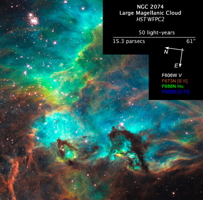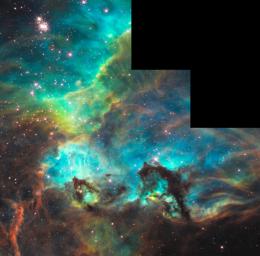
Click on the image
for orientation annotationIn commemoration of NASA's Hubble Space Telescope completing its 100,000th orbit in its 18th year of exploration and discovery, scientists at the Space Telescope Science Institute in Baltimore, Md., have aimed Hubble totake a snapshot of a dazzling region of celestial birth and renewal.
Hubble peered into a small portion of the nebula near the star cluster NGC 2074 (upper, left). The region is a firestorm of raw stellar creation, perhaps triggered by a nearby supernova explosion. It lies about 170,000 light-years away near the Tarantula nebula, one of the most active star-forming regions in our Local Group of galaxies.
The three-dimensional-looking image reveals dramatic ridges and valleys of dust, serpent-head "pillars of creation," and gaseous filaments glowing fiercely under torrential ultraviolet radiation. The region is on the edge of a dark molecular cloud that is an incubator for the birth of new stars.
The high-energy radiation blazing out from clusters of hot young stars already born in NGC 2074 is sculpting the wall of the nebula by slowly eroding it away. Another young cluster may be hidden beneath a circle of brilliant blue gas at center, bottom.
In this approximately 100-light-year-wide fantasy-like landscape, dark towers of dust rise above a glowing wall of gases on the surface of the molecular cloud. The seahorse-shaped pillar at lower, right is approximately 20 light-years long, roughly four times the distance between our Sun and the nearest star, Alpha Centauri.
The region is in the Large Magellanic Cloud (LMC), a satellite of our Milky Way galaxy. It is a fascinating laboratory for observing star-formation regions and their evolution. Dwarf galaxies like the LMC are considered to be the primitive building blocks of larger galaxies.
This representative color image was taken on August 10, 2008, with Hubble's Wide Field Planetary Camera 2. Red shows emission from sulfur atoms, green from glowing hydrogen, and blue from glowing oxygen.

 Planetary Data System
Planetary Data System













